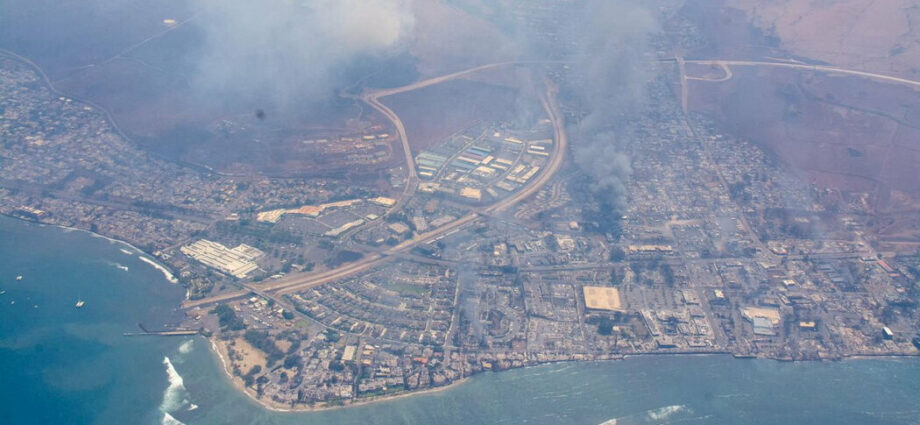The fires in Hawaii would be shocking anywhere — killing at least 36 people, in one of the deadliest wildfires in the United States in modern history. But the devastation is especially striking because of where it happened: In a state defined by its lush vegetation, a far cry from the dry landscape normally associated with fire threats.
The explanation is as straightforward as it is sobering: As the planet heats up, no place is protected from disasters.
The story of this week’s blaze arguably began decades ago, when Hawaii started experiencing a long-term decline in average annual rainfall. Since 1990, rainfall at selected monitoring sites has been 31 percent lower in the wet season, and 6 percent lower in the dry season, according to work published in 2015 by researchers at the University of Hawaii and the University of Colorado.
There are multiple reasons for that change, according to Abby Frazier, a climatologist at Clark University who has researched Hawaii.
One factor is La Niña, a weather pattern that has usually led to significant rainfall but began delivering less precipitation beginning in the 1980s. Those weaker La Niñas “are not bringing us out of drought,” Dr. Frazier said in an interview earlier this year.
Another change: As temperatures increase, the clouds over Hawaii are thinner, Dr. Frazier said. And less cloud cover means less precipitation. On top of that, big storms have been moving north over time — delivering less of the rainfall that they typically bring to the islands.
All three changes are probably related to rising temperatures, Dr. Frazier said. “There’s likely a climate change signal in everything we see,” she said.
Almost 16 percent of Maui County, where the wildfires are burning, is in severe drought, according to data issued by the U.S. Drought Monitor on Thursday; an additional 20 percent is in moderate drought.
As average annual rainfall has been decreasing, average temperatures in Hawaii, like elsewhere in the world, have increased, further drying out the vegetation. In a paper published in 2019, University of Hawaii researchers wrote that 2016 was warmer than the 100-year mean by .92 degrees Celsius, and temperatures had been inching up by .19 Celsius per decade at the Mauna Loa Observatory.
Hawaii’s landscape is changing in other ways, beyond becoming drier. As wildfires become more common, some native vegetation, which is poorly adapted to fire, has been destroyed. In other places, including the area around Lahaina, longstanding sugar cane farms stopped operating around the 1990s; the land stopped getting irrigated.
In the place of those crops and native vegetation, dry and invasive grasses spread. Those grasses that are better able to regrow after a fire, but are also quick to ignite. That has contributed to fires spreading more quickly.
“The landscape is just covered with flammable stuff,” said Ryan Longman, a research fellow at the East-West Center, an educational institution. “All of the conditions just came together.”
The drying out of Hawaii’s landscape is part of a trend affecting rainforests around the globe.
Rainforests are highly sensitive to changes in precipitation. Higher temperatures, drought and changes in rain patterns stress trees. Their trunks dry up, and their leaves fall. Thinning canopy allows sun rays to reach the soil, causing it to dry up quickly.
Over decades, drought, heat, fire and deforestation can force a rainforest to transition into dry grasslands, or savanna.
Parts of the Amazon rainforest, the biggest in the world, are fast approaching this transition, a point of no return when the humid ecosystem would forever change.
Degraded forests and changing weather patterns combine to create perfect conditions for fires, often started by human activity, to grow into enormous, uncontrollable blazes. In tropical forests, tree loss because of fire has grown 5 percent on average each year over the past 20 years, according to recent research.
Those underlying threats were amplified in Hawaii this week by a separate threat: Hurricane Dora, which passed south of Hawaii as a Category 4 storm on Tuesday. Though the storm was hundreds of miles off the coast of Maui, it contributed to wind speeds of greater than 60 miles per hour, helping the fire to spread at a ferocious speed.
It’s difficult to directly attribute any single hurricane to climate change. But by increasing air and ocean temperatures, warming conditions make it more likely for large storms to gain strength.
“The massive winds, dry winds, are what drove this fire,” said Josh Stanbro, who served as chief resilience officer for Honolulu. “This is part of a long-term trend that is directly related to climate changes and impacts on the islands.”
Judson Jones contributed reporting.
Christopher Flavelle is a Washington-based climate reporter for The Times, focusing on how people, governments and industries try to cope with the effects of global warming. More about Christopher Flavelle
Manuela Andreoni is a writer for the Climate Forward newsletter, currently based in Brazil. She was previously a fellow at the Rainforest Investigations Network, where she examined the forces that drive deforestation in the Amazon. More about Manuela Andreoni
Source: Read Full Article
-
Ex-girlfriend shared video of last embrace with Cardiff crash victim
-
Does Peter Dutton comprehend the damage of his doubts?
-
Tesco using barriers as shoppers try snatch reduced items from staff
-
Furious motorists blast Sadiq Khan over plans to expand ULEZ
-
Ukrainian military claims Wagner army group was involved in training Hamas

